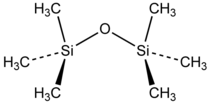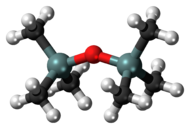Hexamethyldisiloxane (HMDSO or MM) is an organosilicon compound with the formula O[Si(CH3)3]2. This volatile colourless liquid is used as a solvent and as a reagent in organic synthesis. It is prepared by the hydrolysis of trimethylsilyl chloride. The molecule is the protypical disiloxane and resembles a subunit of polydimethylsiloxane.

| |

| |
| Names | |
|---|---|
| Preferred IUPAC name
Hexamethyldisiloxane | |
Other names
| |
| Identifiers | |
3D model (JSmol)
|
|
| Abbreviations | HMDSO, (TMS)2O |
| 1736258 | |
| ChEBI | |
| ChemSpider | |
| ECHA InfoCard | 100.003.176 |
| EC Number |
|
| MeSH | Hexamethyldisiloxane |
PubChem CID
|
|
| RTECS number |
|
| UNII | |
| UN number | 1993 |
CompTox Dashboard (EPA)
|
|
| |
| |
| Properties | |
| C6H18OSi2 | |
| Molar mass | 162.379 g·mol−1 |
| Appearance | Colourless liquid |
| Density | 0.764 g·cm−3 |
| Melting point | −59 °C (−74 °F; 214 K) |
| Boiling point | 100 to 101 °C (212 to 214 °F; 373 to 374 K) |
| 930.7±33.7 ppb (23 °C) [1] | |
| Vapor pressure | 43 hPa (20 °C) [2] |
Refractive index (nD)
|
1.377 |
| Hazards | |
| Occupational safety and health (OHS/OSH): | |
Main hazards
|
|
| GHS labelling: | |
  [2] [2]
| |
| Danger[2] | |
| H225, H410[2] | |
| P210, P233, P240, P273, P403+P235[2] | |
| NFPA 704 (fire diamond) | |
| Flash point | −1(1) °C |
| Related compounds | |
Related compounds
|
|
Except where otherwise noted, data are given for materials in their standard state (at 25 °C [77 °F], 100 kPa).
| |
Synthesis and reactions
editHexamethyldisiloxane can be produced by addition of trimethylsilyl chloride to purified water:
- 2 Me3SiCl + H2O → 2 HCl + O[Si(CH3)3]2
It also results from the hydrolysis of silylethers and other silyl-protected functional groups. HMDSO can be converted back to the chloride by reaction with Me2SiCl2.[3]
Hexamethyldisiloxane is mainly used as source of the trimethylsilyl functional group (-Si(CH3)3) in organic synthesis. For example, in the presence of acid catalyst, it converts alcohols and carboxylic acids into the silyl ethers and silyl esters, respectively.[4]
It reacts with rhenium(VII) oxide to give a siloxide:[5]
- Re2O7 + O[Si(CH3)3]2 → 2 O3ReOSi(CH3)3
Niche uses
editHMDSO is used as an internal standard for calibrating chemical shift in1H NMR spectroscopy. It is more easily handled since it is less volatile than the usual standard tetramethylsilane but still displays only a singlet near 0 ppm.
HMDSO has even poorer solvating power than alkanes. It is therefore sometimes employed to crystallize highly lipophilic compounds.
It is used in liquid bandages (spray on plasters) such as cavilon spray, to protect damaged skin from irritation from other bodily fluids. It is also used to soften and remove adhesive residues left by medical tape and bandages, without causing further skin irritation.
HMDSO is being studied for making low-k dielectric materials for the semi-conductor industries by plasma-enhanced chemical vapor deposition (PECVD).
HMDSO has been used as a reporter molecule to measure tissue oxygen tension (pO2). HMDSO is highly hydrophobic and exhibits high gas solubility, and hence strong nuclear magnetic resonance spin lattice relaxation rate (R1) response to changes in pO2. Molecular symmetry provides a single NMR signal. Following direct injection into tissues it has been used to generate maps of tumor and muscle oxygenation dynamics with respect to hyperoxic gas breathing challenge.[6]
References
edit- ^ Sudarsanan Varaprath; Cecil L. Frye; Jerry Hamelink (1996). "Aqueous solubility of permethylsiloxanes (silicones)". Environmental Toxicology and Chemistry. 15 (8): 1263–1265. doi:10.1002/etc.5620150803.
- ^ a b c d e Record of Hexamethyldisiloxane in the GESTIS Substance Database of the Institute for Occupational Safety and Health, accessed on November 10, 2021.
- ^ Röshe, L.; John, P.; Reitmeier, R. “Organic Silicon Compounds” Ullmann’s Encyclopedia of Industrial Chemistry. John Wiley and Sons: San Francisco, 2003. doi:10.1002/14356007.a24_021.
- ^ Pfeifer, J. "Hexamethyldisiloxane" in Encyclopedia of Reagents for Organic Synthesis (Ed: L. Paquette) 2004, J. Wiley & Sons, New York. doi:10.1002/047084289X.
- ^ Schmidt, M.; Schmidbaur, H., "Trimethylsilyl perrhenate", Inorg. Synth. 1967, 9, 149-151. doi:10.1002/9780470132401.ch40
- ^ Kodibagkar VD, Cui W, Merritt ME, Mason RP. A novel 1H NMR approach to quantitative tissue oximetry using hexamethyldisiloxane. Magn Reson Med 2006;55:743–748 and Kodibagkar VD, Wang X, Pacheco-Torres J, Gulaka P, Mason RP. Proton Imaging of Siloxanes to map Tissue Oxygenation Levels (PISTOL): a tool for quantitative tissue oximetry. NMRBiomed 2008;21:899-907.
